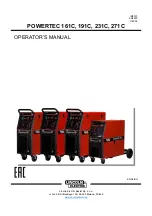
GALA INDUSTRIAL.. Instructions Manual.
28
CHAPTER 5. ANOMALIES. PROBABLE CAUSES. POSSIBLE SOLUTIONS.
SYMPTOM. ANOMALY.
PROBABLE CAUSE.
POSSIBLE SOLUTION.
1. Make sure there is voltage at the entry to the
machine, if not the tapping must be changed. It is
advisable to see if any magnetothermal has "blown".
2. Check that fuse L of the power source is not open.
GENERAL PROBLEM
NOTHING WORKS.
The machine has no voltage in one or all its
vital elements.
3. The machine panels must be removed testing the
logical points of the electrical diagram.
LIMITER TRIPS
Magnetothermal switch has low gauge for the
case. There may be a short circuit, which is
what causes the limiter to trip.
Change the magnetothermal for another larger
gauge one. It is important for the magnetothermal
switch to have a characteristic slow type curve. It is
important for the magnetothermal switch to have a
characteristic slow type curve. In the event that the
electrical installation has limited power the welding
work must be tested at lower current levels.
Problem in the power source-wire feed unit
connection.
Check that the electrical connection between the
power source and the wire-feed unit is correct. The
warning light of the wire-feed unit must be on.
Check the wire-feed fuse. Test the wire-feed electrical
circuit.
Failure of the pistol switch which does not
make perfect contact.
Change the gun microswitch.
ALTHOUGH THE MACHINE IS
CONNECTED AND WITH
LIGHT R ON, THERE IS NO
REACTION WHEN PRESSED
Main electronic board of wire-feed unit faulty.
Replace the electronic card.
WHEN THE GUN IS PRESSED,
ALTHOUGH WIRE COMES
OUT, THE CONTACTOR DOES
NOT WORK OR/AND THERE
IS NO SHIELDING GAS
Voltage does not reach the Contactor or/and
solenoid valve.
It must be established whether the fault comes from
the electronic board or if it is an electrical connection
fault.
Check that the contactor coils or/and solenoid valve
are not open.
WHEN THE SHIELDING GAS
IS RELEASED IT CONTINUES
FLOWING.
There is impurity in the inside chamber of the
solenoid valve which prevents the piston from
closing completely.
Dismantle and clean the electrovalve.
WHEN FINISHING WELDING
THE WIRE REMAINS STUCK
TO THE TORCH CONTACT
TUBE.
The contactor has a very high opening delay.
Suitably adjust the potentiometer of final wire length
existing on the wire-feed unit.
The contactor has a very low opening delay.
Suitably adjust the potentiometer of final wire length
existing on the wire-feed unit.
WHEN FINISHING WELDING
THE FINAL WIRE LENGTH IS
VERY GREAT.
The torch is withdrawn immediately when torch
pushbutton is no longer pressed.
The final wire length control system requires the
welding torch not to be immediately withdrawn when
the torch pushbutton is no longer pressed.
Low effective welding voltage. Output wave
not correct.
Check that there is not a phase failure in the supply
power.
Check that the electrical contact elements of the
welding circuit are correct: Welding mass, rusty or
very dirty surfaces, contact nozzle with greater
diameter than the wire, etc.
Test the electrical diagram of the power source:
input and output voltages to the rectifier.
THE EQUIPMENT DOES NOT
WELD CORRECT.
"IT ADJUSTS BADLY"
The welding wire has a mechanical resistance
at the outlet, which prevents it from having a
regular speed.
Examine the welding gun. Blow the inside (cable)
with compressed air.
Reactance chosen low.
Change reactance tap H on the power source to a
higher value.
THERE ARE MANY
PROJECTIONS IN THE
WELDING PROCESS
Unsuitable shielding gas.
When welding normal steels we advise the use of a
gas mixture Ar-CO2.





































